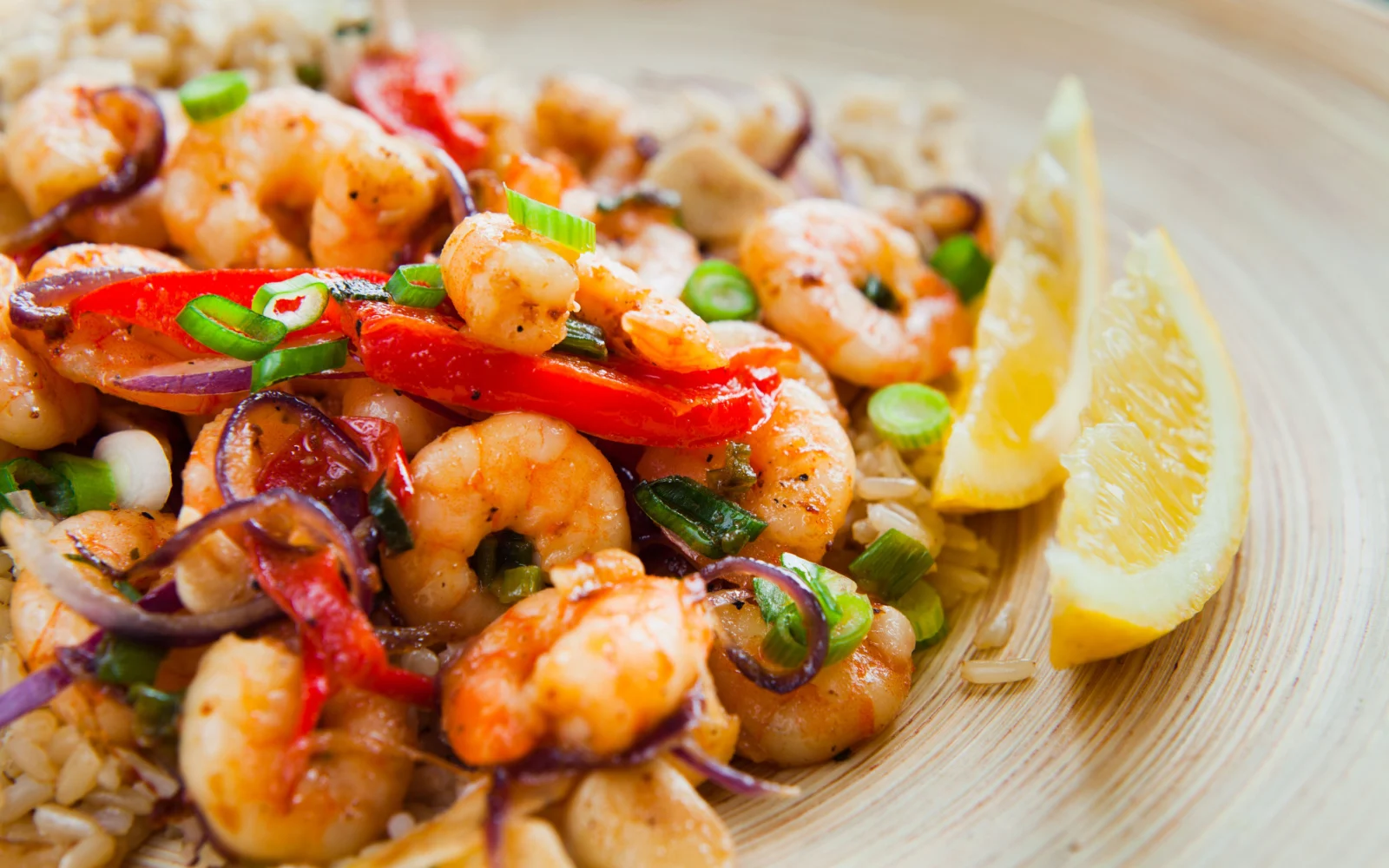The Caribbean is a place where ingredients and techniques from all around the world get to play together with a local bounty of seafood and spice. Imported, Indian-style curry spices meld with native seasonings like allspice.
Bright tropical flavors, fresh fish, and rich sauces combine in tart, spicy, unexpected combinations. The foods you’ll find are one of the world’s original and authentic fusion cuisines.
Colonialism brought people from all over the world to this region. English, Spanish, Portuguese, French and Dutch plantation owners and workers brought the cuisines from their countries to the Americas.
Especially in a place with such a complex history. This is my attempt at an overview, and I’m sure to miss some things or get other things wrong. It’s a skimming of the surface, and a place to start understanding what you see on the menus. And, hopefully, some inspiration for a few dishes to seek out.
A note: The subject of Caribbean cooking is too broad to cover comprehensively in a blog post. There is a mess of influences, contradictory ideas of origins, and a whole lot of other issues when it comes to writing about food.
How Caribbean Food Became Caribbean
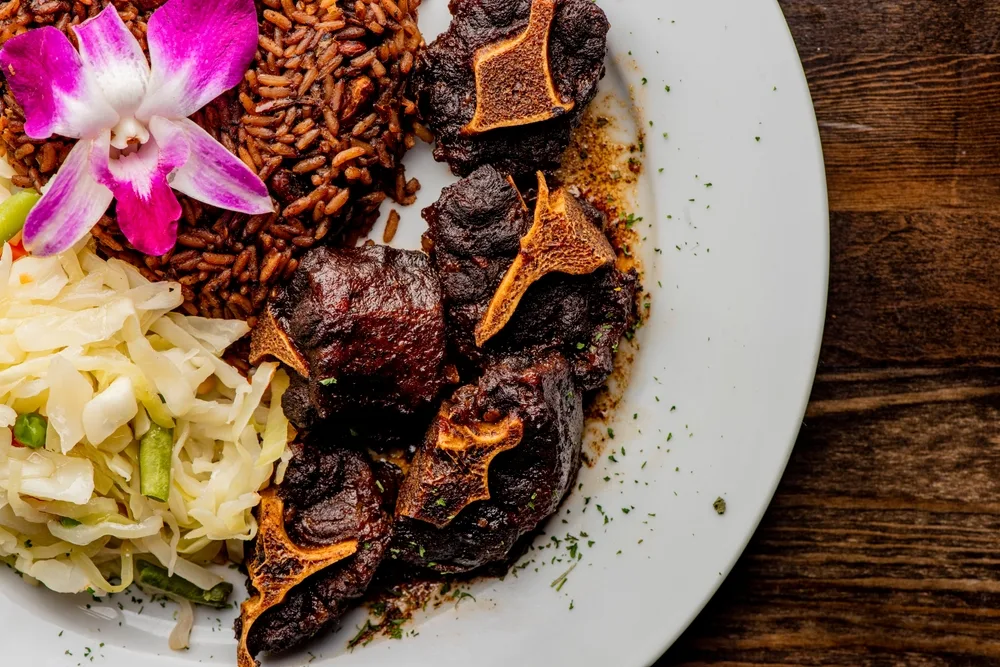
Marie Sonmez Photography/Shutterstock
Indentured and enslaved individuals from West Africa, India, South Asia, and Arab countries mixed their food traditions with European ones and indigenous ingredients. Spanish colonists brought sofrito, a method of sweating aromatics in oil, which cooks all around the region incorporated.
When British loyalists fled the nascent United States, they (and their enslaved servants) brought foods of the American South like grits, macaroni pie and potato salads. West Africans brought cassava, okra, and plantains.
There are some ingredients you’ll find by different names throughout the Caribbean. For instance, the root called cassava in Jamaica is known as yuca in Spanish-speaking countries.
You’ll find many foods that are eaten throughout the region, as well as ones that are a specialty of one locale. Don’t just eat at the resort and beach restaurants.
Instead, head to the shacks and the food trucks. Seek out what’s on the menu for the people who live there every day. If you go to the Caribbean and all you eat are badly fried grouper bites, you’re missing out on so much good food.
What Is Caribbean Food?
When you head to the Caribbean, be on the lookout for delicacies like these:
Conch
Conch is a sea snail that can grow over a foot in length. It’s an herbavore that lives in shallow areas among seagrass and algae beds. The meat is highly prized and has been eating since before recorded history.
Today, you’ll see these giant arthropods in a range of dishes throughout the Caribbean. The meat is tough but flavorful, and preparations have developed over years that make the most of it. Conch fritters are a Bahamian dish.
The meat is chopped fine, then mixed into a batter and deep-fried. Seasonings typically include aromatics like pepper, onion, and celery. They’re eaten either with a creamy sauce or a squeeze of lime. Cracked conch is another fried preparation.
The meat is pounded until thin to tenderize it. Then, it’s breaded and deep-fried. Cutting back on fried foods? Consider a conch salad. This ceviche-like dish mixes the fresh meat with an acid like lemon or lime, sweet onion, tomato, and bell and hot peppers.
Curry
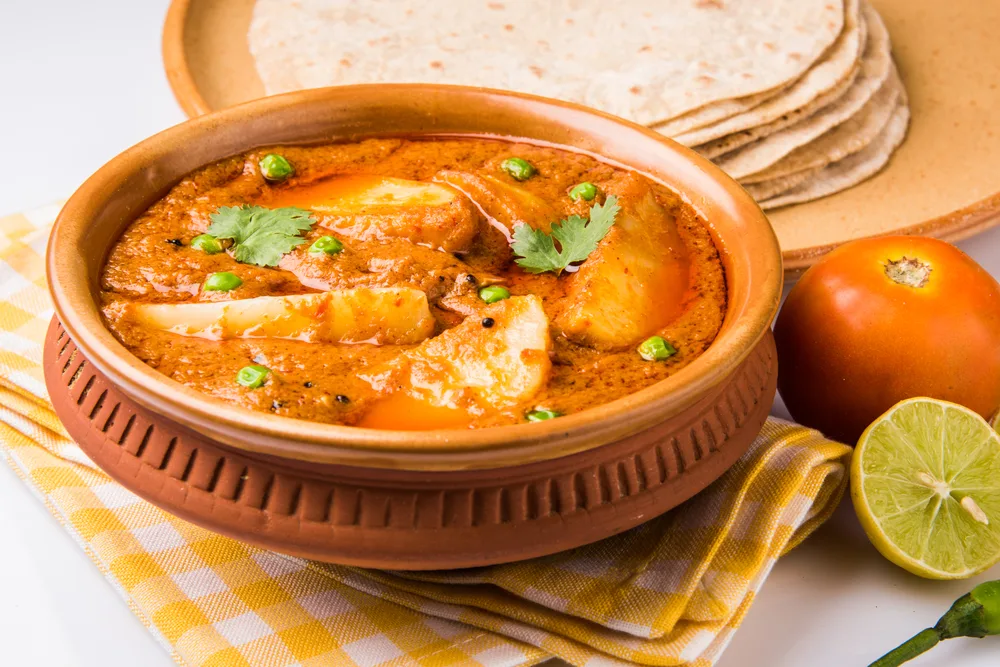
StockImageFactory.com/Shutterstock
“Curry” isn’t one particular spice or one specific dish. Instead, it refers to both premade spice mixes and the flavorful dishes you can make with them. When British colonists invaded India, spices were part of the bounty.
They brought those seasonings back to the UK. Then, they brought both the adapted English dishes made with them and indentured workers from India into colonies in the Caribbean in the 1800s. Between 1834 and 1917, over 100,000 Indian people migrated to Trinidad and Tobago.
Another 36,000 went to Jamaica. Curries are prevalent now throughout Caribbean countries previously under British rule. This includes Jamaica, Guyana, St. Kitts & Nevis, and Trinidad and Tobago. Curries throughout the Caribbean have different characters.
An off the shelf powder or sauce will be augmented with fresh aromatics and spices. You’ll find curries of fish, crab, chickpeas, goat, chicken, and more. You’ll also see that Indian influence in the side dishes: roti, a flatbread common in India, is often available as a side.
Jerk Chicken
Jerk chicken is a dish that combines cooking methods and ingredients from West Africa and the native Taino people. The dish starts with marinating the meat overnight in a solution spiced with scotch bonnet peppers, thyme, green onion, fresh ginger, and allspice, a berry native to Jamaica.
Then, it’s smoked over the resinous wood from the allspice bush, called pimento. Slow cooking produces tender, flavorful meat with a smoky, complex flavor.
Ackee and Saltfish
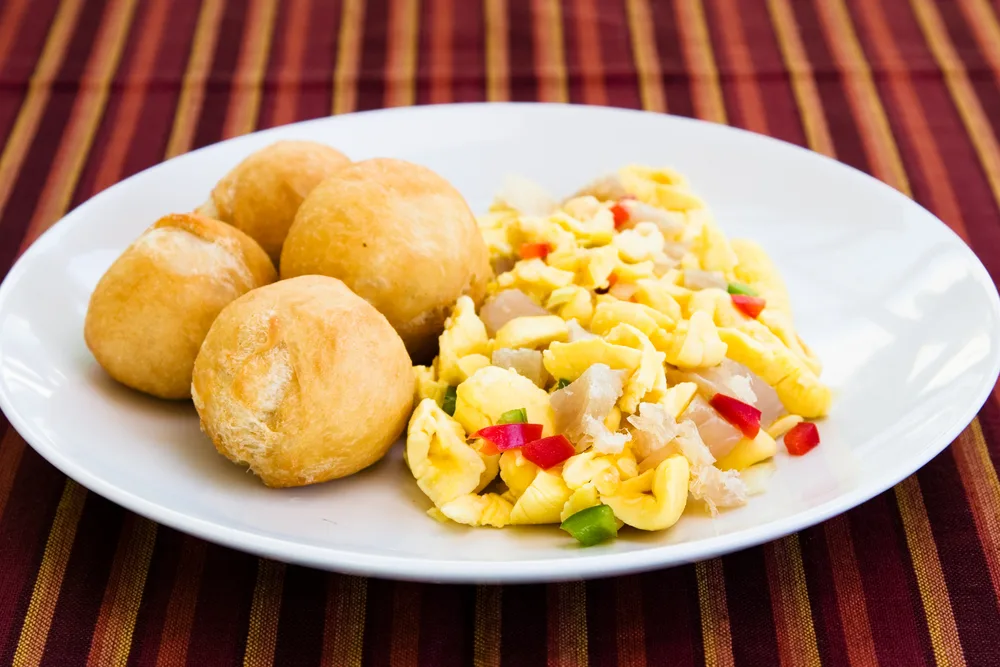
Rohit Seth/Shutterstock
While many people associate jerk chicken most strongly with Jamaica, that’s not the country’s national dish. That honor goes to ackee and saltfish, a popular meal that combines imported staples with local produce. The saltfish is salted cod, which was brought to Jamaica by the British.
It was a cheap protein that could be used to feed plantation workers. Since the fish was thoroughly dried and impregnated with salt, it could last for months even at tropical temperatures.
To be palatable, the fish needs to be rehydrated in several changes of water, then stewed. Ackee was one of the crops brought over by enslaved West African people. The fruit is toxic when green, but becomes edible when ripened and prepared correctly.
The fish and ackee are stewed together with peppers and spices to create a warm, comfort food meal. This dish is closely related to the national dish of Saint Lucia, Green figs and salted cod. The “green figs” in the name, by the way, refer to green bananas.
Callaloo
Long cooked greens are a common side throughout the Caribbean. A dish of callao could include just the leaves of that plant. Or, it could be a dish of slow cooked greens that include other leafy greens like spinach and amaranth.
The greens are simmered with onion, garlic, peppers, and other aromatics. In Trinidad, you’ll find versions that include pumpkin and coconut milk. In Jamaica, a dish of callaloo might include tomatoes and Scotch bonnet peppers.
Plantains
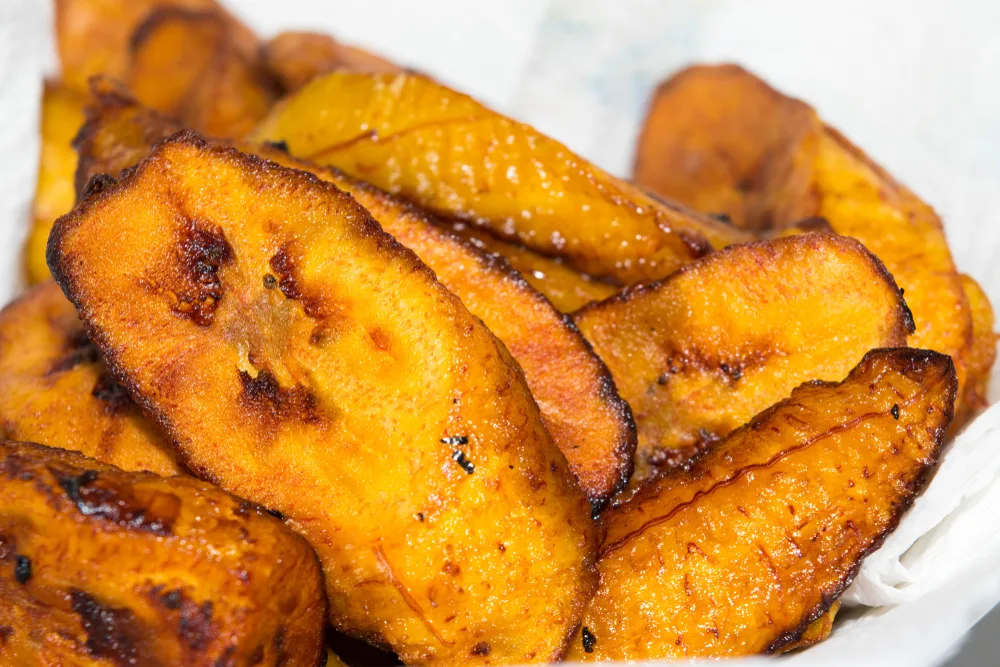
Red Confidential/Shutterstock
These banana cultivars have less sugar and more starch than the bananas you eat out of hand. They’re eaten at all stages of development. When green, the starchy fruits are fried, boiled, or even added to curries.
They get sweeter as they ripen. When the fruit peels turn black, they are just right for marduros, another type of fried plantains that are sticky, sweet, and tart.
Green bananas are also commonly used as a savory food. In some parts of the Caribbean, like Saint Lucia, you’ll see them called “green figs.” They can be stewed, added to casseroles, or otherwise used anywhere and any way you would add a starch to a meal.
Roast Pork
Pigs were brought to the Americas with Columbus and other Europeans. They thrive in a range of environments and could be raised with little fuss. As a result, pork has been a part of the Caribbean diet for hundreds of years.
Roast pork is typically a celebratory meal, such as the Puerto Rican pernil served during the holidays. As with other foods on this list, you’ll see different preparations in different parts of the region.
In Jamaica, it’s slow cooked and seasoned with dark brown sugar, vinegar, cinnamon, and other spices. In the Bahamas, it might be seasoned with lime juice and rum.
Rice and Peas
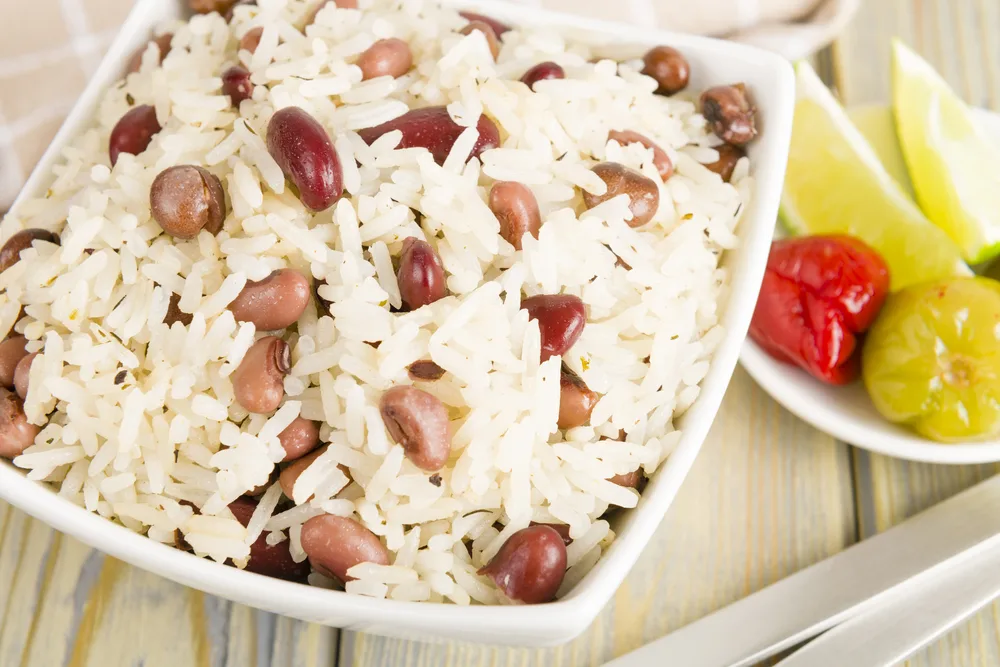
Paul_Brighton/Shutterstock
Starches and legumes rule the Caribbean table. These were and are cheap staples that can keep big groups of people fed. They’re shelf stable options that are always available even without refrigeration.
In Latin American preparations, you’ll see the emphasis reversed, with beans getting top billing over the rice. In Jamaica, Barbados, the Bahamas, and other destinations, the dish goes heavier on the rice than the legumes.
The “peas” are typically pigeon peas, which happily grow in hot climates with sparse irrigation. Sometimes rice and peas is offered alone, other times it is a side dish served with meat.
Fried or Grilled Fish
Mahi-mahi, snapper, grouper, and kingfish are all plentiful in Caribbean waters. You’ll most often see these items prepared simply so the natural flavors shine. Grilled preparations are common, with just a touch of lime.
Deep-friend or pan fried renditions show up all over, as well. In Jamaica, seek out stewed or steamed fish dishes. These are often made with snapper. Stews will often have a characteristic brown sauce. The steamed fish is a light and healthy option that can be just the thing in the middle of days of feasting.
Lobster
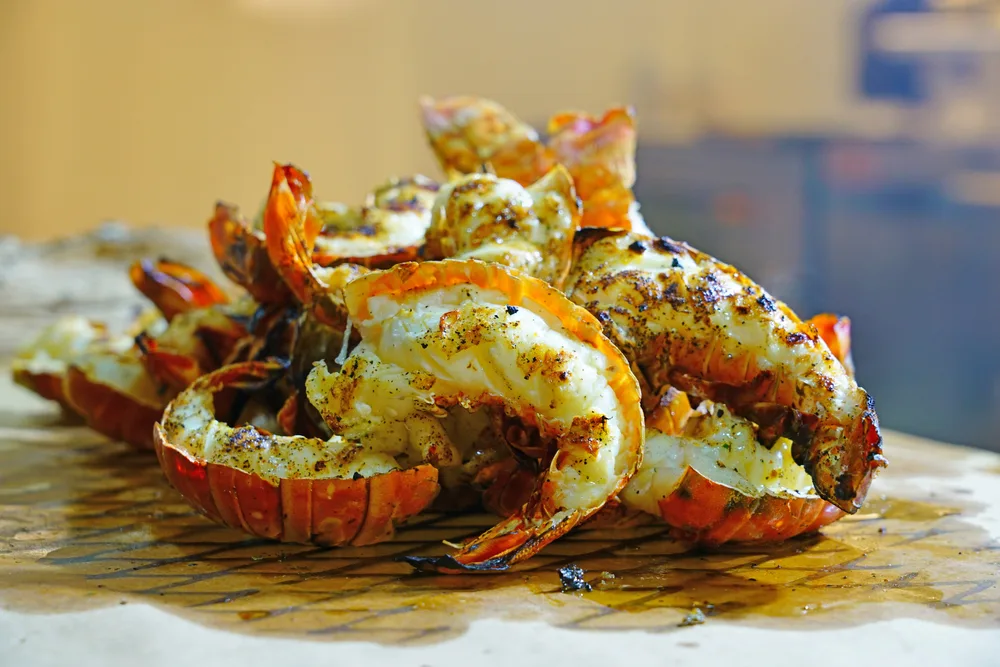
EQRoy/Shutterstock
The lobster you’ll see in the Caribbean is not the same as you’ll find swimming in supermarket tanks throughout the US. Spiny lobster is clawless and is harvested for its meaty tail.
Preparations are usually simple. You may see a lobster pie or curry, but it’s just as common to see it boiled or steamed, then split and served with butter and lemon.
Rum Cake
Steamed Christmas puddings are a British invention that gets an island spin in places throughout the Caribbean. In Trinidad and Tobago, it’s “black cake,” a fruit cake made with cherry brandy and dark rum.
In Puerto Rico, it’s a sponge cake soaked in local rum. One of the advantages of these booze soaked cakes is that they’re dense, long lasting, and travel well. This makes them a popular and delicious souvenir to pick up before you head home.
Frequently Asked Questions
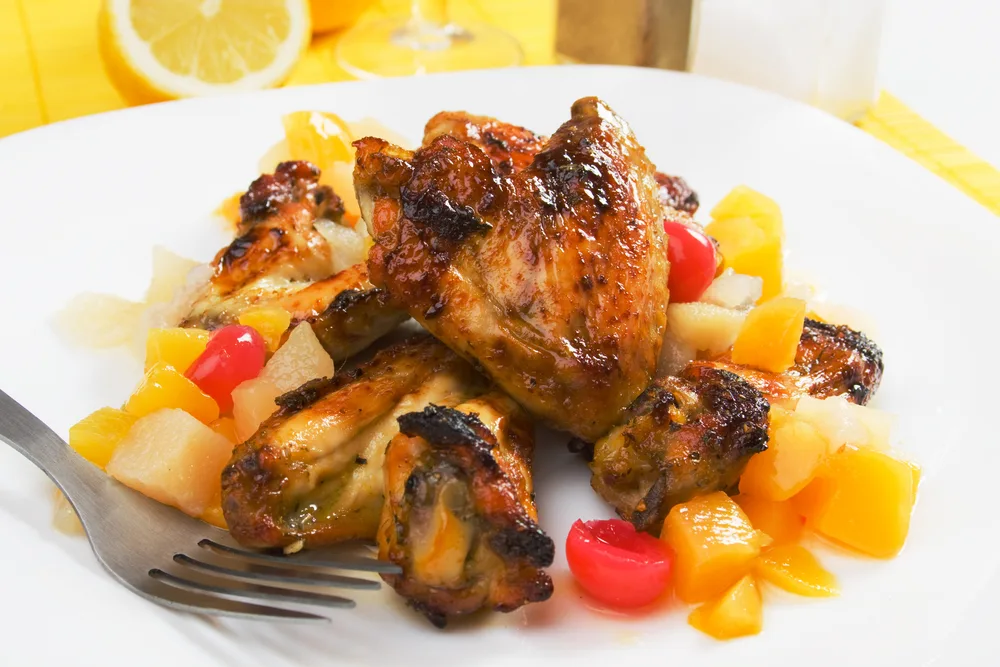
Igor Dutina/Shutterstock
Still have questions? These are answers to some common ones:
What is considered Caribbean food?
Food from countries that include Jamaica, the Bahamas, Puerto Rico, the Dominican Republic, and more are all Caribbean foods.
Are Jamaican and Caribbean food the same?
Jamaican food is Caribbean, but not all foods in the Caribbean hail from Jamaica. While many ingredients and preparations are common throughout the region, each country has a few ingredients specific to them, as well as unique ways of cooking.
What does Caribbean food taste like?
Caribbean food encompasses tastes from all over the world. You can find flavors that include hot spices, piquant sauces, and bitter greens.
What is unique about Caribbean food?
Caribbean foods are all fusion cuisines. They blend local tropical ingredients with cooking traditions from West Africa, China, India, Latin America, and Europe.
Summing Up: What Is Caribbean Food?
Caribbean food is the culmination of multiple cultures coming together over hundreds of years. It includes foods from disparate origins all over the world, all brought together in a place with a wealth of seafood and spice.
Get outside your comfort zone and try out the specialties of the people in your host countries when you head down to the Caribbean.



